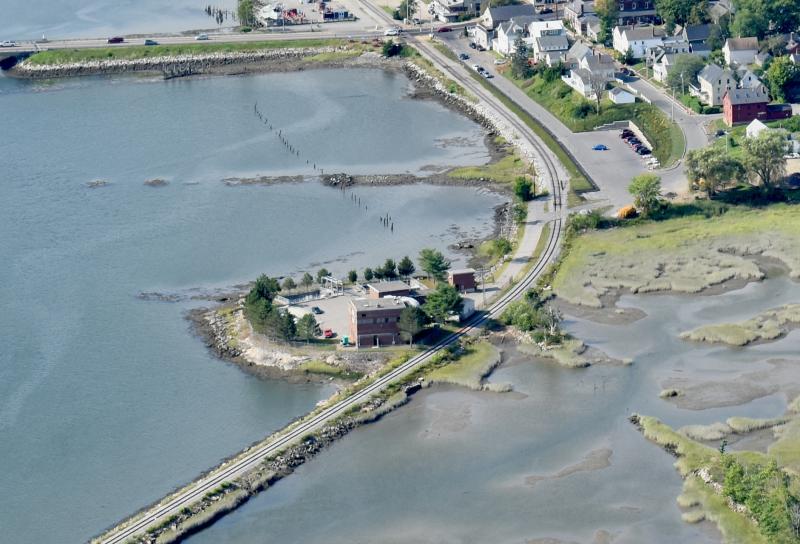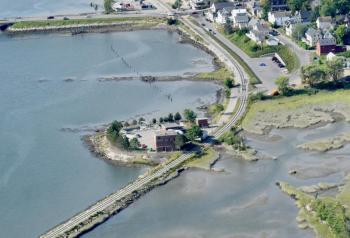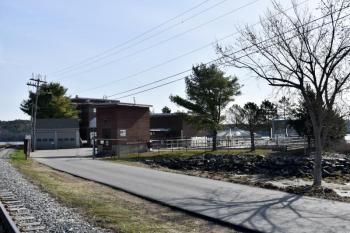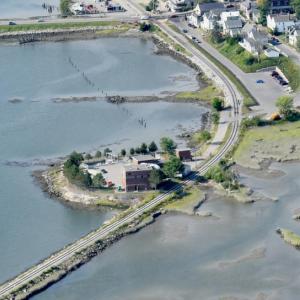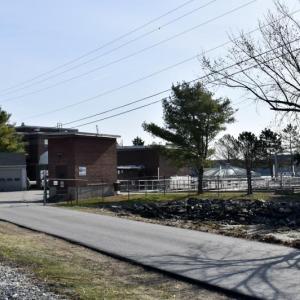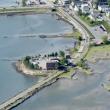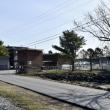Sewer plant’s problem location, location, location
Asked what letter grade he would give Wiscasset’s sewer treatment plant, Town Manager Dennis Simmons responded, probably a C-. The facility approaching its 60th year of operation at the upper end of Railroad Avenue remains reliable during normal weather conditions and capable of meeting clean water standards. The problems, wrote Simmons in an email to Wiscasset Newspaper, occur during extended periods of heavy rain: The plant sits on a small island surrounded on three sides by tidal waters – a cause for concern during periods of storm surge.
A Climate Adaptation Plan for making the facility more resilient to flooding and sea level rise was approved by Maine Department of Environmental Protection. But according to Simmons, it will be “exceedingly difficult” for Wiscasset to get needed state and federal dollars for infrastructural needs that include constructing a sea wall around the island.
Simmons estimated the cost of providing flood resiliency at the plant at over $7 million. “However, this option (building a sea wall) appears to be off the table at the moment.” The issue,! Simmons explained, “is the Environmental Protection Agency does not want us on this tiny island surrounded by tides that are only 10 feet from coming into our parking lot. EPA wants us at a location much higher above the expected future storm/tide levels.”
Finding a suitable site will be challenging. Simmons said one possible location is on Birch Point, home to the former Mason Station power plant. Wiscasset owns land here that has the needed higher elevation along with the advantage of being close to the river. Simmons said a drawback is its great distance from the current sewer plant. “As such, it would require re-routing numerous pipelines and adding a number of new pump stations to send sewage to the new location,” he explained. With an approximate cost of $45 million-plus, it is also the most expensive option.
Other locations Simmons mentioned included two intown properties. One, along the river, is behind the elementary school on Federal Street; the site is just across the back bay from the current plant. Another possible option would be to build where the public works building is, on Sandhill Road.
“Both provide much higher elevations that are above flood levels and would cost an estimated $35 million-plus requiring less re-routing of existing sewer mains,” Simmons stated. On the negative side, both sites would likely result in considerable resistance from the neighborhood, he said. He added it was uncertain if the needed property could be acquired by the town for either site.
With the price tag of a new sewer plant running between $35 million and $45 million or greater, Simmons said the town will definitely need help in financing the construction. “We’ll pursue all grants and funding options.” He has said agencies that might help will expect the town to tap into its approximately $12 million reserve. He added April 26, he has no idea how much money the town will have to put into the project.
As far as treatment plants go, Wiscasset’s is a smaller facility with under 900 customers; 700 residential, 119 commercial, eight governmental and one industrial. The system has about 14 miles of sewer main along with 18 pump stations; the plant meets Occupational Safety and Health Administration (OSHA) safety standards, but not all Americans with Disability Act codes.
Simmons was asked if there were any planned renovations or major upgrades at the plant within the 2023-24 budget year. “Nothing for the plant itself. We have submitted an application with the Clean Water State Revolving Fund for $2.56 million for upgrading pumping stations 3 and 4,” he replied.
The last major expansion of Wiscasset’s sewer services was when main was laid under the Sheepscot River to Davis Island, Edgecomb. Simmons mentioned there had been recent interest in expanding sewer services in Wiscasset further north on Gardiner Road and south on Route 1 into Woolwich. The plant was built in 1963-64; two upgrades have taken place, the most recent in 1992.

